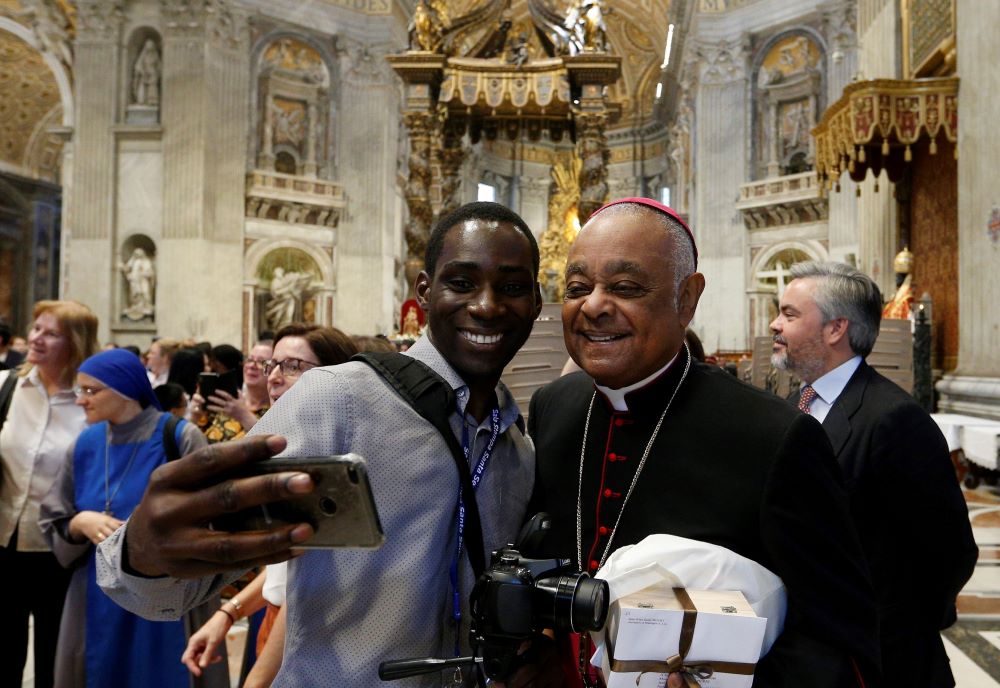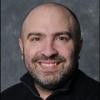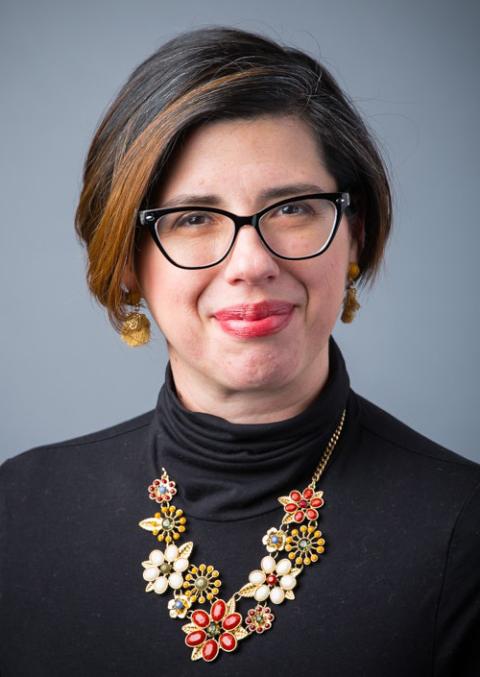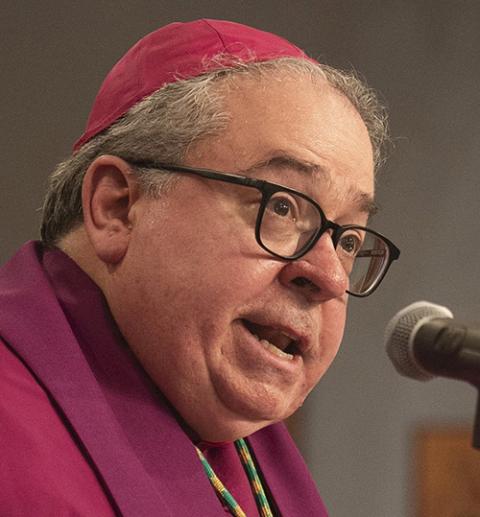
Archbishop Wilton Gregory of Washington holds a box containing his pallium — a vestment symbolizing his office and communion with the Holy See — as he poses with a well-wisher after Pope Francis' celebration of Mass marking the feast of Sts. Peter and Paul in St. Peter's Basilica at the Vatican June 29, 2019. Gregory, who was installed on May 21, 2019, as the seventh archbishop of Washington, turned 75 in December. (CNS photo/Paul Haring)
If Pope Francis continues to serve as bishop of Rome for another two years, he may have a notable opportunity to refashion the U.S. Catholic hierarchy. Dozens of bishops, several in historically significant archdioceses, will be required by canon law to submit resignation letters upon turning 75.
At least 13 archdioceses and 21 dioceses could have new episcopal appointments by February 2025. In addition, two dioceses — Fairbanks, Alaska, and Houma-Thibodaux, Louisiana — are operating without bishops. The number of episcopal openings could increase because of deaths or resignations.
If he names new bishops to all those local churches, Francis will have appointed 64 percent of the U.S. episcopate since becoming pope in March 2013. Forty-six percent of current U.S. bishops are Francis appointees, said Catherine Hoegeman, a Missouri State University sociology professor who tracks U.S. episcopal appointments.
"Over the next two years, it looks like Francis is going from [having appointed] a little less than half of active bishops to a little less than two-thirds. I think that's a notable shift," said Hoegeman. Since 1969, she said, popes have made an average of 15 episcopal appointments every year in the United States.
Cardinal Robert W. McElroy of San Diego holds his crosier as he speaks with journalists before Mass on the campus of the University of San Diego Sept. 8, 2022. He was elevated to the cardinalate Aug. 27. (CNS photo/David Maung)
She also told NCR that the likely openings in the next two years represent an unusually high potential turnover among archbishops. "Out of 34 total retirements in the next couple of years, a third of them are going to be in the archdioceses. That seems to be a little skewed with a higher percentage of archdiocesan retirements," Hoegeman said.
By February 2025, the archbishops of New York, Hartford, Chicago, Cincinnati, Detroit, Kansas City, Milwaukee, Omaha, Houston, Mobile and New Orleans will have turned 75. Cardinal Wilton Gregory of Washington turned 75 in December 2022. Cardinal Sean O'Malley of Boston turns 79, four years beyond the traditional retirement age, in June.
Meanwhile, seven sitting bishops have already turned 75 and another 14 will hit the retirement age over the next two years in dioceses across the country — from Honolulu and Kalamazoo, Michigan, to Palm Beach, Florida and Portland, Maine.
Although Catholic bishops must send resignation letters to the pope upon reaching age 75, Francis can decide to let a bishop remain in position up to age 80.
Whether all the potential new bishop appointments translate into a U.S. Catholic hierarchy that more closely reflects Francis' priorities is unknown.
Church historians and other scholars told NCR that the "talent pool" of potential bishops was primarily formed in the pontificates of John Paul II and Benedict XVI, both of whom inspired conservative-leaning men to enter seminaries with visions of fighting "the culture of death" and the "dictatorship of relativism."
'I don't know that the pool of potential bishops and cardinals is of the caliber where we would really get revolutionary change in the U.S. hierarchy.'
— Natalia Imperatori-Lee
"To have great bishops, you need great seminaries. You need vibrant engagement with the intellectual life of the church, and I just don't see that happening," said Natalia Imperatori-Lee, chair of religious studies at Manhattan College in the Bronx, New York.
Imperatori-Lee told NCR that she believes the pope will have a difficult time finding enough "Francis-type bishops" in the United States to change the church's path from an institution engaged in the culture wars to one that more faithfully models Francis' "culture of encounter."
"I am hopeful the men who Francis appoints will be in the style that he has done, men who are pastors first, and bureaucrats second, who are not careerist climbers," she said. "But I don't know that the pool of potential bishops and cardinals is of the caliber where we would really get revolutionary change in the U.S. hierarchy."
No 'perfect' bishop candidates
In an interview with NCR, retired Cardinal Justin Rigali, who as a former member of the Vatican's Congregation for Bishops helped advise the pope on which priests to select as bishops, described the process by which those candidates are identified and chosen.
U.S. Cardinal Justin Rigali, retired archbishop of Philadelphia, waves as he arrives for a general congregation meeting at the Vatican March 5, 2013, ahead of the conclave that would elect Jorge Bergoglio pope. (CNS photo/Reuters/Stefano Rellandini)
In the United States, Rigali said that every few years bishops in different regions of the country meet to discuss potential bishop candidates, and send their names to the Vatican's nunciature, or embassy, in the U.S. From there, the ambassador, known as an apostolic nuncio, seeks information from priests, deacons and lay people who know the candidates.
He said when he served at the Congregation for Bishops — now the Dicastery for Bishops — the office would present the pope with a list of three names for a diocese, sometimes with the congregation's recommendation for a particular candidate. Rigali, a former archbishop of St. Louis and Philadelphia, said no candidates are "perfect in every category," but that they reflect the sitting pope's priorities for a bishop.
"There's definitely a common thread; the life of the church in a particular time, and what is deemed appropriate and necessary in the choice of a pastor," Rigali said. "Like anything else, there are going to be some differences of opinion, but we go by what the church teaches and what the Second Vatican Council says about bishops."
Bishop Mark J. Seitz of El Paso, Texas, kneels at El Paso's Memorial Park holding a "Black Lives Matter" sign June 1, 2020. In 2010, he was ordained and appointed as auxiliary bishop of Dallas. In 2013, Pope Francis appointed Seitz as the sixth Bishop of El Paso. He is 69. (CNS/Fernie Ceniceros, courtesy Diocese of El Paso)
Aided by Archbishop Christophe Pierre, the apostolic nuncio since 2016, and his own appointments to the Dicastery for Bishops, Francis' selection of bishops to date in the United States by and large reflect his vision that church leaders should be pastoral and eschew divisive culture wars about issues of sexual morality.
Francis appointees such as Archbishops Paul Etienne of Seattle and John Wester of Santa Fe, New Mexico, as well as Bishops Mark Seitz of El Paso, Shawn McKnight of Jefferson City, Missouri, and John Stowe of Lexington, Kentucky, are among prelates who have been lauded for their pastoral touch and work on issues such as immigration, war, poverty, and outreach to LGBTQ people and other marginalized communities.
"These are the kind of people we should be bringing up to major archdioceses," said Fr. Steve Avella, a church historian at Marquette University who has studied the history of how Catholic bishops have been selected in the United States.
"The [archdioceses] need men of stature, of maturity, of solid theological grounding, and I really hope Francis is paying attention," Avella said.
New cardinals visit with Pope Francis and retired Pope Benedict XVI at the Mater Ecclesiae monastery after a consistory for the creation of 20 new cardinals in St. Peter's Basilica at the Vatican Aug. 27, 2022. (CNS photo/Vatican Media)
Mixed record of 'Francis's bishops'
However, several bishops who were appointed to their dioceses over the last decade have acted in ways that some might not have expected from so-called "a Francis bishop."
One of Francis' 2013 appointments, Bishop Michael Olson in Fort Worth, Texas, in 2022 forced the resignation of the local Catholic Charities president for organizing a women's empowerment summit that Olson saw as being too aligned with "the principles of Diversity, Equity, and Inclusion espoused by postmodern theorists," although a diocesan spokesperson maintains the forced resignation was for "obstinate defiance" and refusing to recognize the bishop's responsibility to "teach the faith and to maintain the Catholic integrity" of the agency's mission.*
Bishop Earl Fernandes of Columbus, Ohio — appointed by Francis in April 2022 — sparked protests when he evicted the Paulist Fathers from campus ministry at Ohio State University within weeks of his installation.
Two bishops whom Francis appointed to Minnesota dioceses in recent years — Robert Barron in Winona-Rochester and Andrew Cozzens in Crookston — have aligned themselves with cultural conservatives who oppose the current pope's priorities.
"The thing that unites all [Francis' episcopal] choices is that he seems to prefer pastoral guys to others. But ideologically, they've been all over the place," said Jesuit Fr. Mark Massa, the director of the Boisi Center for Religion and American Public Life at Boston College.
Massa told NCR that he does not see much willingness from Francis, unlike his two immediate predecessors, to "really reshape the American episcopate."
New York Cardinal Timothy M. Dolan pauses in front of a portrait of Pope Benedict XVI while celebrating Mass for the repose of the late pontiff's soul at St. Patrick's Cathedral in New York City Jan. 1. Dolan was appointed archbishop of New York by Pope Benedict XVI in 2009 and appointed to the College of Cardinals in 2012. He will turn 75 on Feb. 6, 2025. (OSV News/Gregory A. Shemitz)
"Under John Paul II and Benedict, there seemed to be a unified field theory about who should be a bishop, and they were all basically bishops in their image," Massa said. "But I have been stymied to try to figure out what Francis' agenda is. I think it's simply to appoint pastoral bishops, and he's less concerned about where they are ideologically. Because otherwise, it seems that his appointments are completely random."
Massimo Faggioli, a theologian and church historian at Villanova University, told NCR that Francis has had "a mixed record for sure" on episcopal appointments because he has had to "work with what's available."
"His choices for cardinals and for promotion [to archbishops] have been successful. They've been very intentional and very strategic," said Faggioli, who referenced Francis creating cardinals like Blase Cupich in Chicago, Joseph Tobin in Newark and Robert McElroy in San Diego.
"But on many other appointments, the record is mixed," Faggioli said, "Because there was the expectation or promise that they were going to be Francis-like bishops. Instead they are vaguely good pastors but not something you would necessarily see as an episcopate that's shaped by Francis' pontificate."
Boston Cardinal Sean P. O'Malley arrives to attend the funeral Mass of Pope Benedict XVI in St. Peter's Square at the Vatican Jan. 5. O'Malley turns 79 in June. That's four years beyond the traditional retirement age for Catholic bishops. (CNS photo/Paul Haring)
Avella, the church historian, told NCR that he has scratched his head at some of Francis' appointments.
"Some of these men who are in positions of authority are either not very competent, not very in tune with the culture, or have just become de facto the Republican Party at prayer," said Avella, who added that issues like LGBTQ rights and the church's message on abortion require intelligent and sophisticated responses that he suggested most prelates are not capable of delivering.
"These issues are crying out for responsible, intelligent and pastoral leadership on the part of bishops, and they are going to require a little more oomph than even [Cardinals] Cupich, Tobin, or even at this point McElroy have been able to give," Avella said.
Imperatori-Lee of Manhattan College said that selecting more Hispanic bishops to reflect the growing Latino Catholic community in the United States could promote cultural sensitivity at the national bishops' conference and change the tenor of the church's engagement in culture war issues.
"It would be symbolically important, and it could potentially be ecclesiologically important as well," she said.
Advertisement
Hoegeman, the Missouri State University professor, told NCR that there is "definitely a pool of liberal-leaning bishops" who Francis could appoint to one of the archdioceses, but she added that archbishops tend to be older when promoted.
"It will be interesting to see where someone like Cardinal McElroy goes as these major sees open up," said Hoegeman, who added that it is more likely that in 2025 the American hierarchy will reflect Francis more in the sense that it will have fewer culture warriors.
"You might not be getting a bunch of Cupichs or McElroys" made bishops, Hodgeman said, adding it is also unlikely that hardline conservatives will rise in the mold of Joseph Strickland of Tyler, Texas, or retired Archbishop Charles Chaput of Philadelphia.
"The middle ground guys will be appointed," she said.
*Editor's note: This paragraph has been updated to reflect the diocesan spokesperson's version of the resignation.










